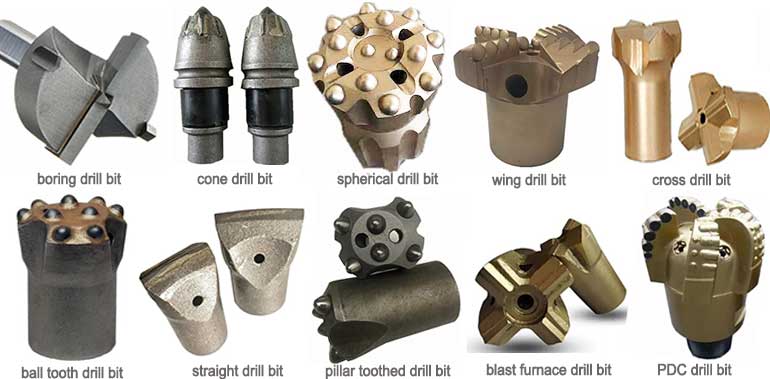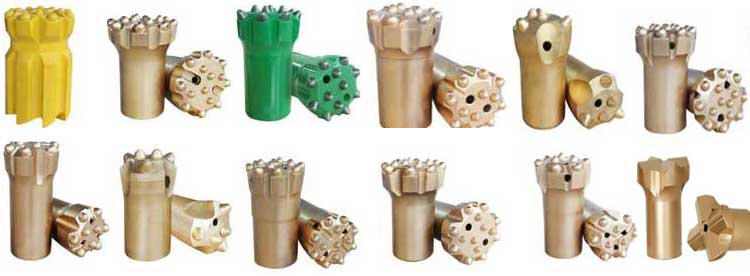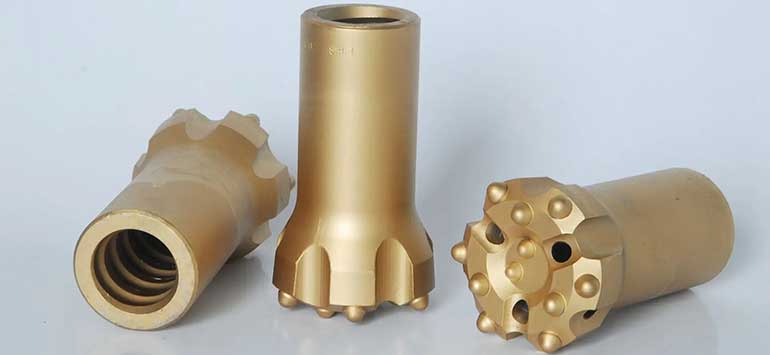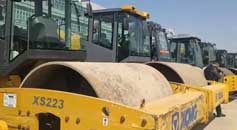10 Types of Rock Drill Bits | How To Choose Drill Bits
A rock drill bit is a tool used to drill holes in hard materials such as rock and concrete. Different drill bits have different features and can perform efficient and accurate drilling work in various environments.
Rock Drill Bits Types
There are various types of rock drill bits, and the following are 10 common types:

- Boring Bit: Boring bit is usually used to drill large diameter holes, including single tooth boring bit and double tooth boring Bit. Single tooth boring drill bits are suitable for rocks with high hardness such as limestone and granite, while double tooth boring drill bits are suitable for rocks with low hardness.
- Cone Drill Bit: The design of the cone drill bit ensures high drilling accuracy, regular aperture, and easy insertion and extraction. It is suitable for different types of rock penetration and blasting operations, such as granite, limestone, etc. It is also suitable for drilling situations such as jet holes and grouting holes.
- Spherical Drill Bit: Spherical drill bits are mainly used for drilling spherical cavities, such as drilling cores.
- Wing Blade Drill Bit: divided into flat bottom wing blade drill bits and spherical wing blade drill bits. Flat bottom wing drill bits are suitable for blast holes and fault detection holes before rock blasting, while spherical wing drill bits are suitable for blasting drilling in underground tunnel projects such as tunnels and subways.
- Cross Drill Bit: The cross shaped drill bit blades are arranged in a cross shape, with a 30%~50% increase in wear resistance compared to a straight shape. The geometric structure is very stable, easy to produce and process, the blade fixing quality is good, the number of blade cuts is large, easy to operate, and can adapt well to different rock drilling conditions.
- Ball Tooth Drill Bit: The ball tooth drill bit is designed to improve drilling efficiency and reduce labor intensity for workers. The tooth shapes it uses mainly include spherical, conical, and conical spherical shapes. Among them, the cone shaped drilling has the highest efficiency, the ball toothed drilling has the best wear resistance and strength, and the cone spherical drilling is in the center.
- Straight Drill Bit: suitable for lightweight rock drills to drill low hardness rock layers, making it easy to grind.
- Pillar Toothed Drill Bit: mainly suitable for dry and wet drilling of medium hard and sturdy rocks.
- Blast Furnace Drill Bit: mainly suitable for steelmaking and ironmaking, it is a high-temperature resistant drill bit.
- PDC Drill Bit: Composite drill bits mainly used for geological survey and exploration, suitable for soft to medium-hard rock formations. It can be used with lower drilling pressure and higher rotational speed, high drilling footage and low cost per unit footage.
The drill bit of a rock drill is an important component of a rock drill, and selecting the appropriate drill bit is of great significance for improving drilling efficiency and reducing costs.

How To Choose Drill Bits
When selecting a rock drill bit, several key tips need to be considered:

- Rock Features: The first thing to consider is the rock type, hardness, and structure. Different rocks require different types of drill bits. For example, for hard rock, it may be necessary to choose harder and more wear-resistant drill bits, such as tungsten steel drill bits; For softer rocks, a lighter and more economical drill bit can be chosen.
- Drill Bit Size: Select the corresponding size of drill bit based on the model and specifications of the rock drill. The threads and body of the rock drill bit should meet the geometric dimensions and quality requirements specified in the standard to ensure stability and efficiency when drilling in rock. Smaller drill bits are used on lightweight rock drills, while larger drill bits are suitable for use on large rock drills.
- Drill Bit Shape: Different shapes of drill bits are suitable for different working environments. For example, impact drills are more suitable for use in heavy load environments because they can reduce the vibration and impact of the drill bit. Meanwhile, different drill bits are equipped according to the hardness of different ores. For minerals with weaker hardness, circular or conical heads can be selected, while for minerals with stronger hardness, it is recommended to use angular and conical heads.
- Drill Bit Material: The cutting edge material of the rock drill bit should meet the requirements of the standard to ensure that it can remain sharp and effectively break the rock during the drilling process. High hardness alloy steel drill bits have strong wear resistance and can maintain stability in size and shape even in strong impact environments.
- Drill Bits Match Drill Rods: It is necessary to reasonably match drill bits and drill rods, such as reaming drill rods or rock breaking drill rods, to better adapt to actual working conditions.
- Drill Bit Maintenance & Replacement: The drill bit requires regular blade replacement or other maintenance to ensure its performance and lifespan. Considering the cost of drill bits, choosing drill bits that are easy to maintain and replace can reduce downtime and maintenance costs.
- Safety: Select drill bits with safety locking mechanisms, anti fracture designs, and other safety features to ensure the safety of personnel and equipment during operation.
 Rock Drill | Working | Types | How To Choose Rock Drill
Rock Drill | Working | Types | How To Choose Rock Drill 10+ Rock Types That Can be Used As Building Materials
10+ Rock Types That Can be Used As Building Materials 20 Types of Excavator Buckets and How To Choose A Suitable Bucket
20 Types of Excavator Buckets and How To Choose A Suitable Bucket Open Pit Mine Perforation Blasting [Shocking Video]
Open Pit Mine Perforation Blasting [Shocking Video]

